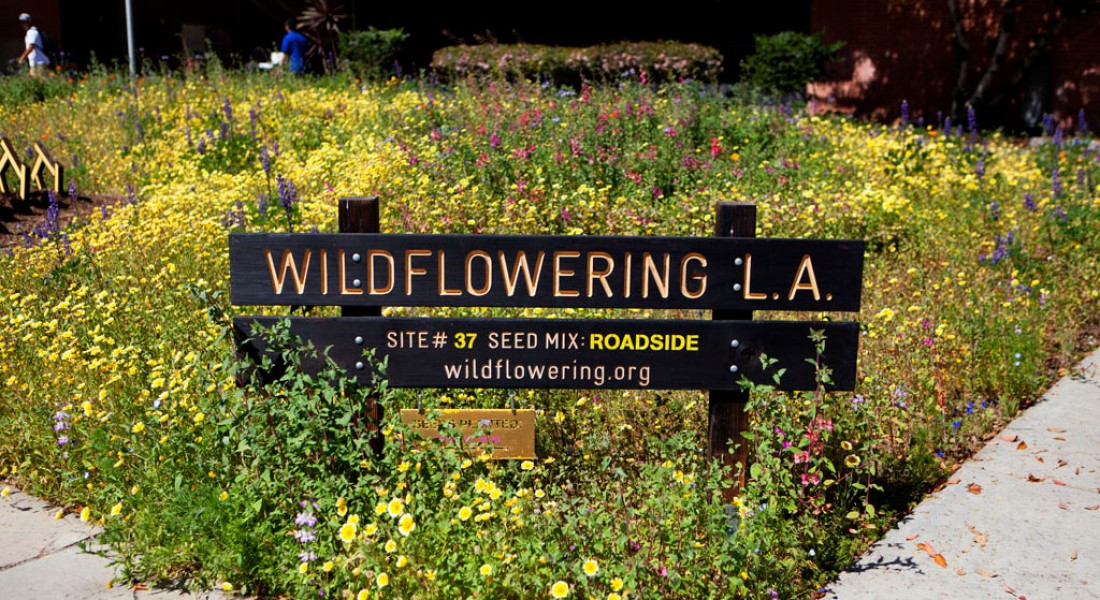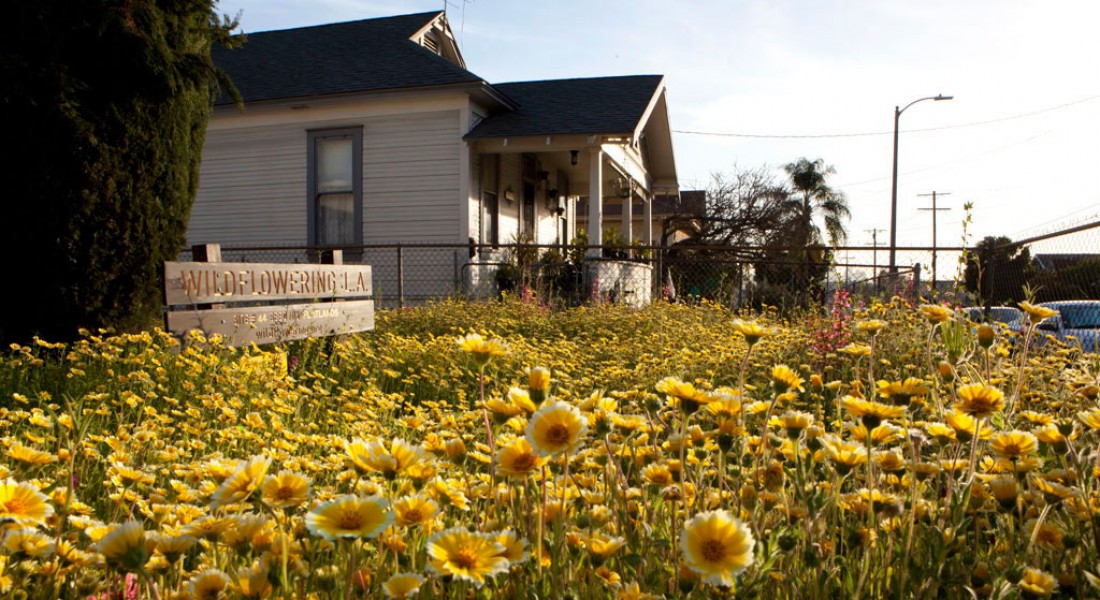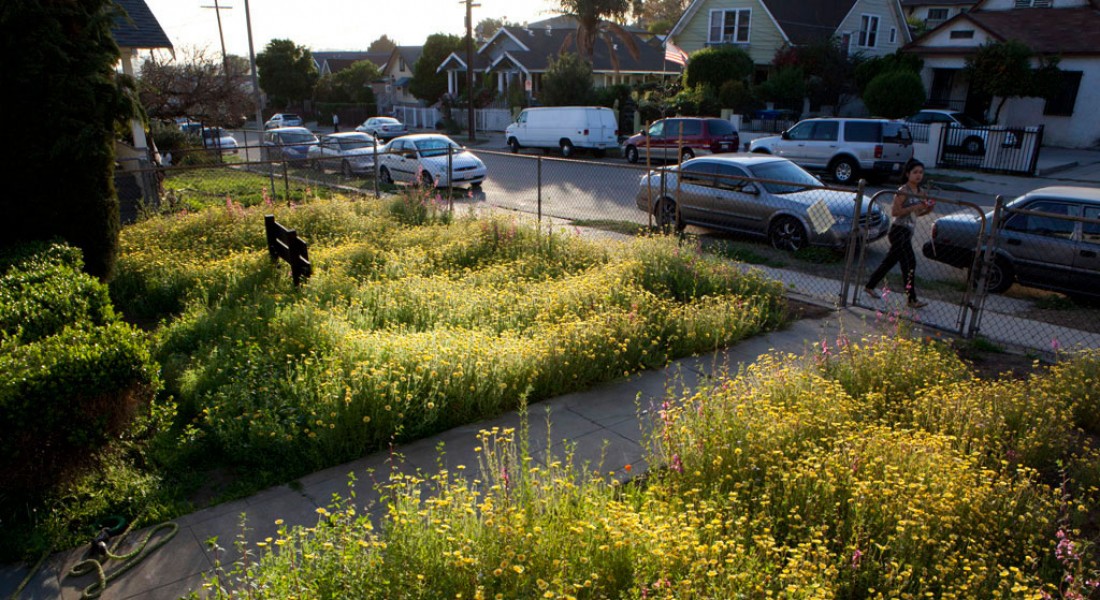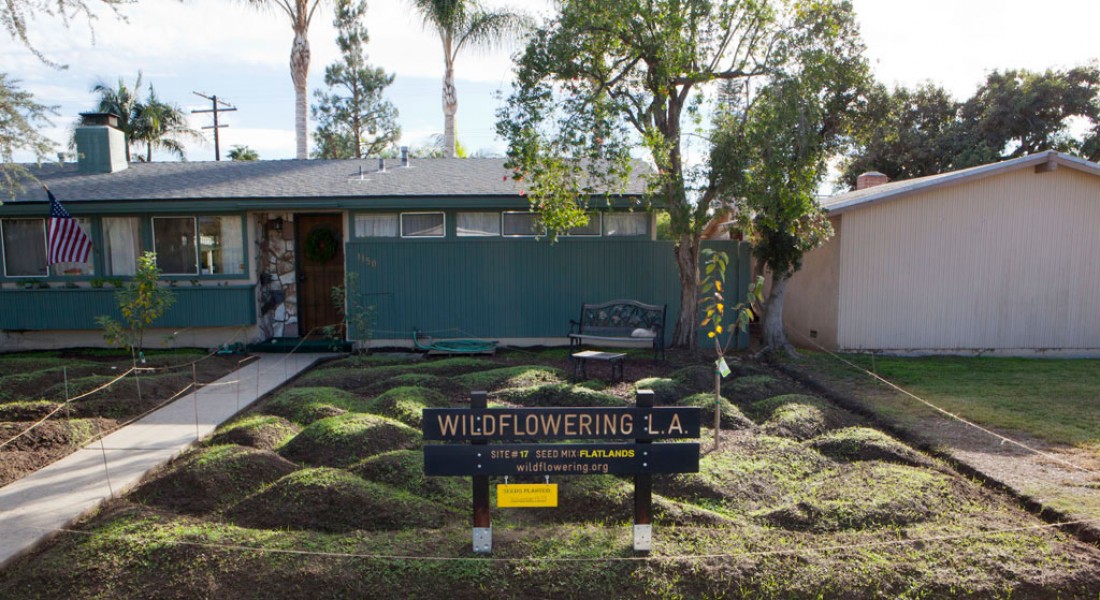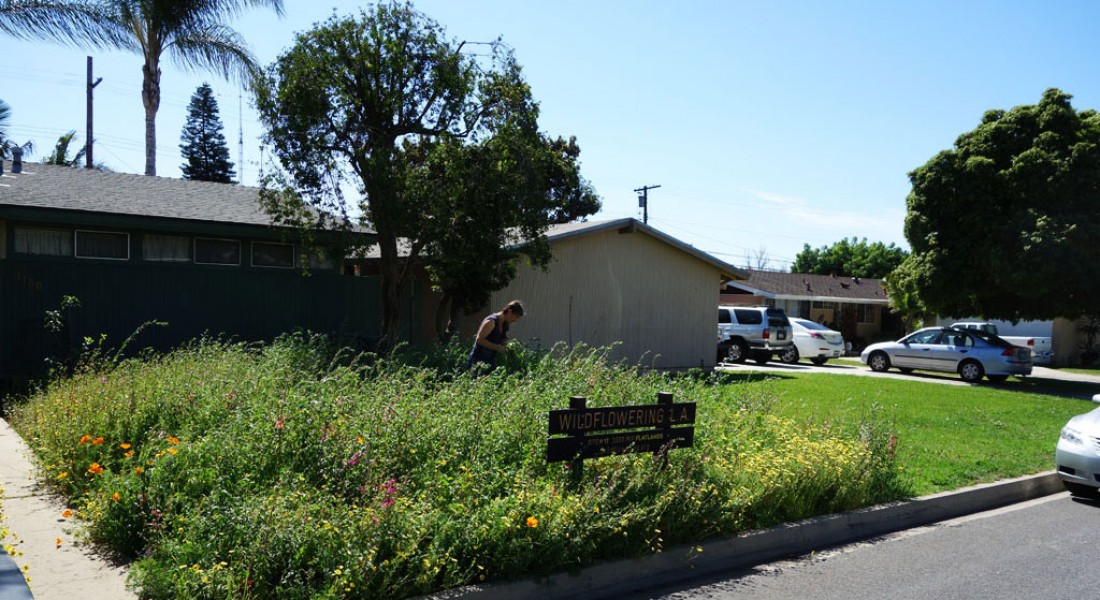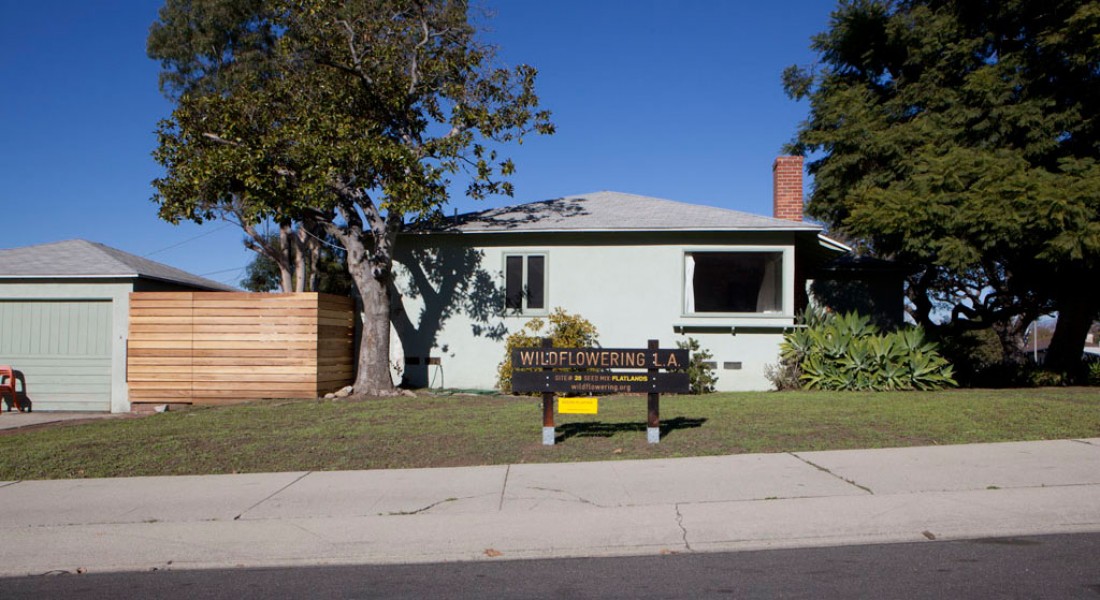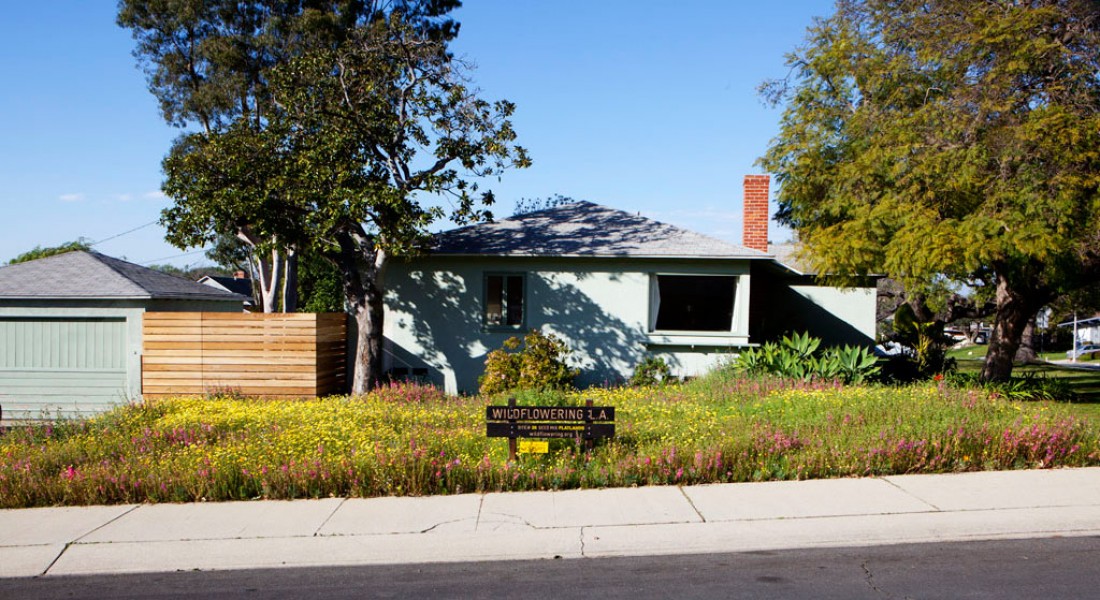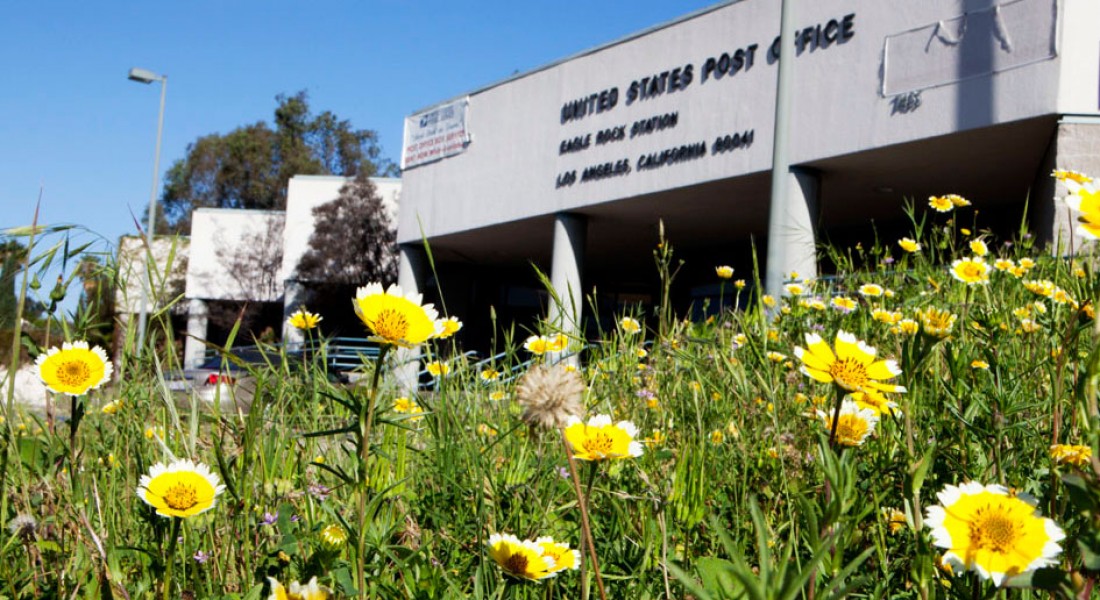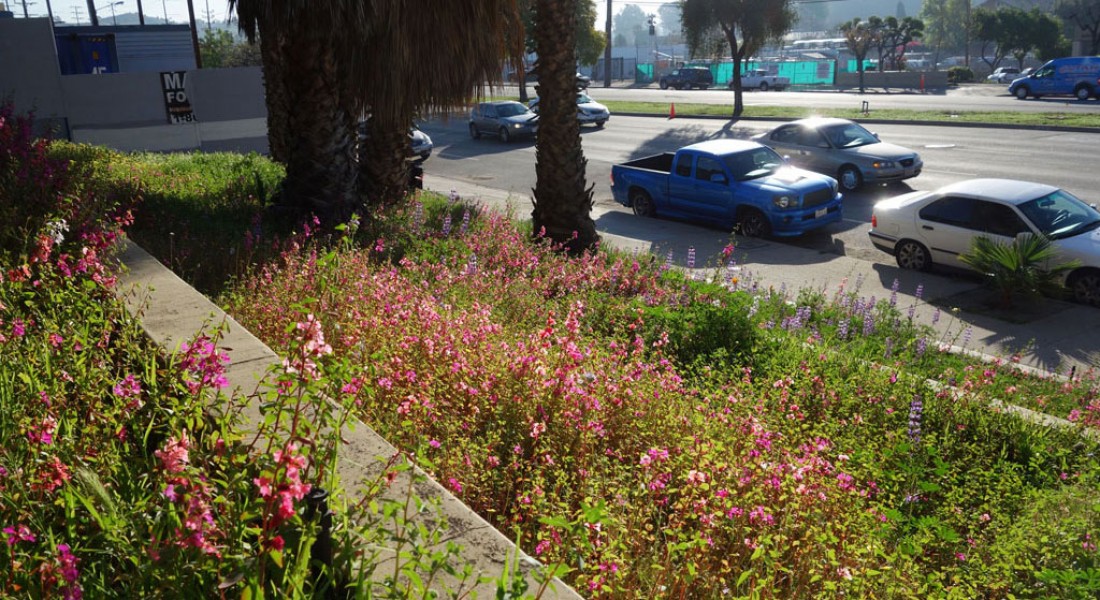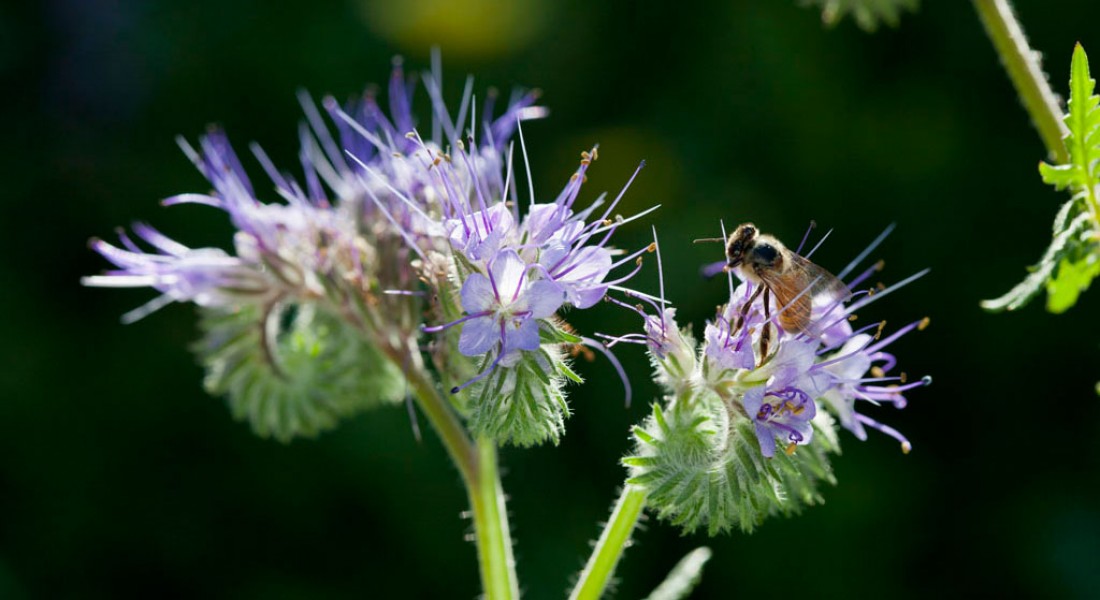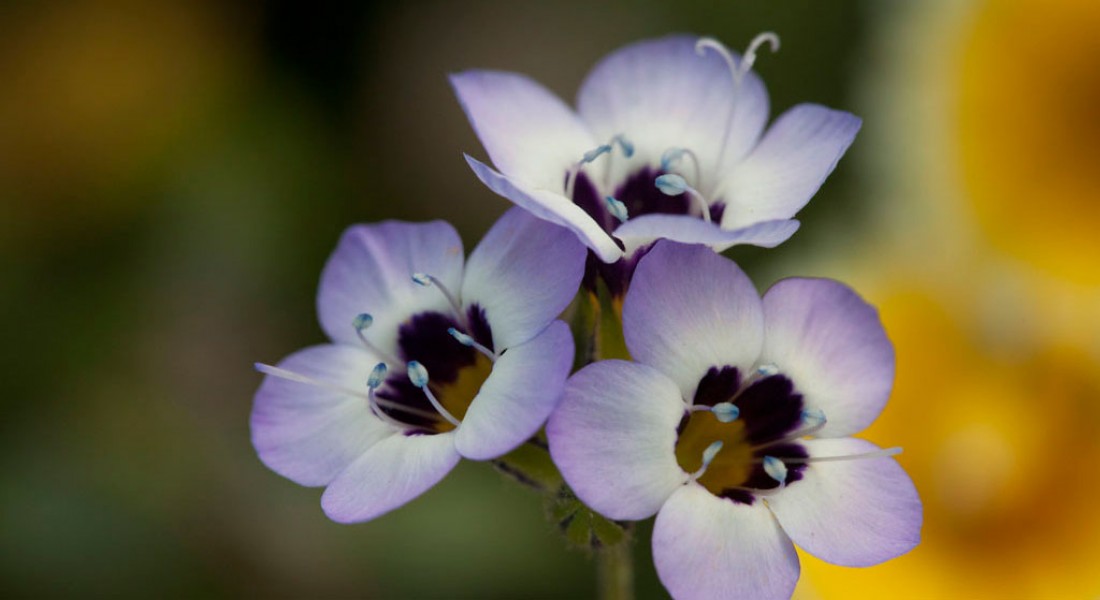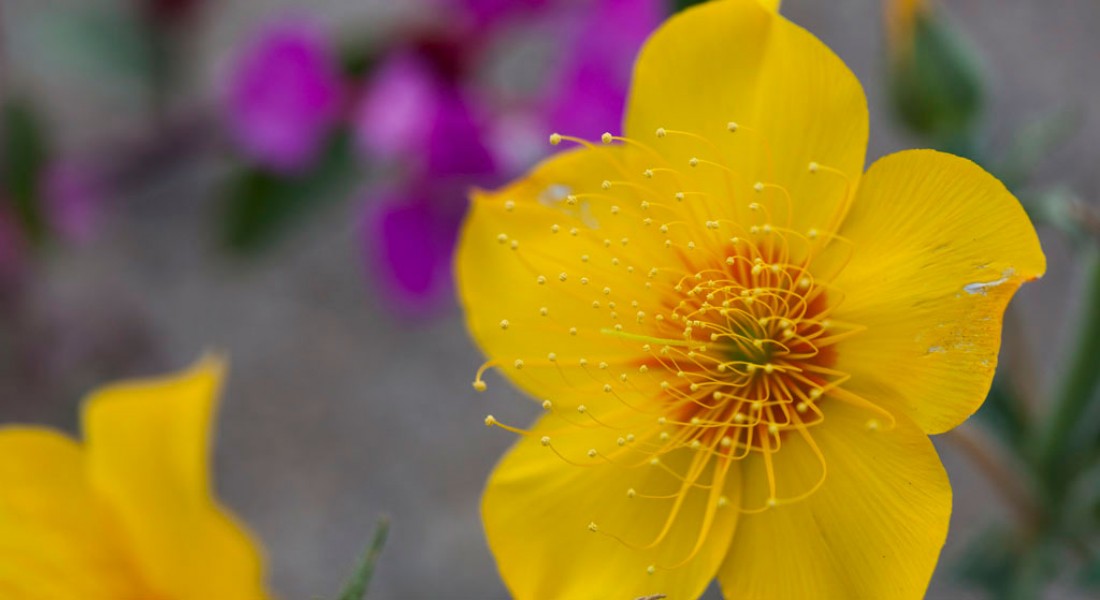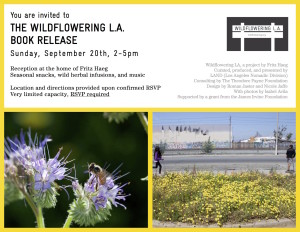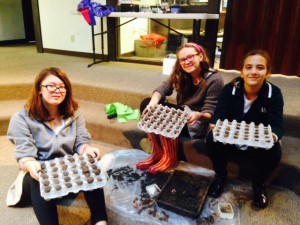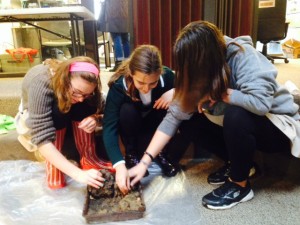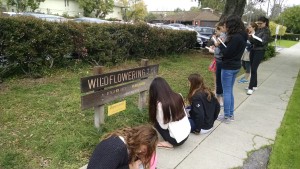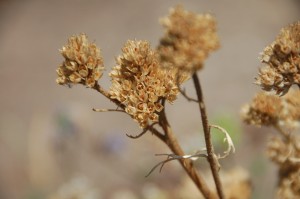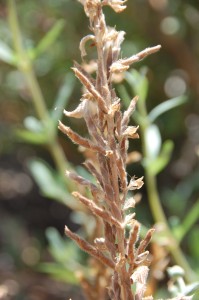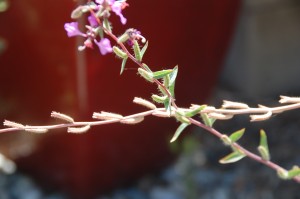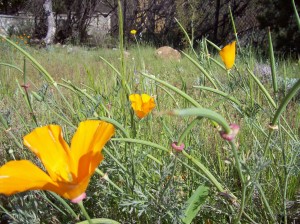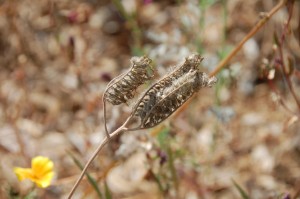Buy a Copy of the Wildflowering L.A. Publication!
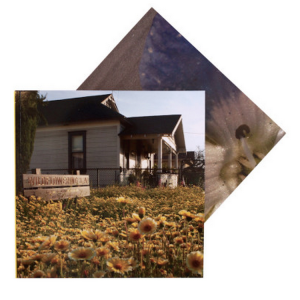 Available HERE through LAND’s website!
Available HERE through LAND’s website! WILDFLOWERING L.A. BOOK RELEASE
Update: Westridge Site #13 One Year Later
One year later, as spring approaches once again, we are heading towards a re-bloom at a few of last year’s Wildflowering L.A. sites, some of which were selected by Fritz Haeg to maintain their signs for public purpose. Among these, Westridge School is continuing to pursue a curriculum involving students in Wildflowering L.A. and the wildflowers are in the first stages of bloom after a hopeful amount of rain in December 2014.
As part of the school’s continuing 7th Grade Service Learning Program, students took part in activities coordinated by Leigh Adams, making seed balls out of seeds harvested from last year’s Wildflowering L.A. Site 13 and the Arboretum (supplemented by seed purchased from Stover Seed Company) to plant in a habitat garden at Westridge. Over one hundred seed balls were made by students on a rainy afternoon. In mid-February, English teacher John Cross also brought students on class forays to the Wildflowering L.A. site to have students do “listening and witnessing” at the garden while keeping in mind works by poets Emily Dickinson, Akahito, and Mary Oliver.
When I went out
In the Spring meadows
To gather violets,
I enjoyed myself
So much that I stayed all night.
-Akahito, Nara poet, 8th Century Japan
Check out the photos below, and stay tuned for more updates from the sites.
One Day On Earth
The vibrant colors of last spring’s majestic and tall Wildflowering L.A. native flower fields in front yards of sites 25, 28, 31, and 42 are a sight to behold in this fall weather — take a peek! The fields were documented as part of the One Day on Earth Project, a documentary that once a year captures the same 24-hour period throughout every country across the world. This year happened on 4/26/2014. Many thanks to Ryan Maxey and Josh Polon for approaching Fritz Haeg and LAND with the project!
Wildflowering L.A. – One Day in Los Angeles from Maxey Fish and Sea on Vimeo.
Soil Solarization: May All Your Weeds Be Wildflowers!
Wildflowering L.A.‘ers – in particular those who battled weeds during the 2013-2014 Wildflowering L.A. project – as well as those of you reading this who are inspired by our collective project and wish to plant their own wildflower meadow this year….
Take note: it’s the time of the year to solarize your soil!
Only during hot, high summer when days are long and temperatures soar can gardeners perform soil solarization—a non-chemical control for soil-borne pests, including those dreaded weed seeds.
The good news is: it’s not a difficult process and can easily be completed in just an afternoon with lasting effects.
When done right, an enormous number of weed seeds are killed, meaning your 2014-2015 wildflower meadow (or your new native garden, if you’re converting to long-lived plants) will be more beautiful and easier to maintain. Less weeding is more time to watch the bees, butterflies and other beneficial insects that love to visit native flowers!
A group of staff and volunteers recently solarized Wildflowering L.A. Site #21 at the base of Wildflower Hill at the Theodore Payne Foundation in Sun Valley.
Here are the basics of solarizing:
- Clear the area of all plant material and any sharp objects such as rocks.
- Wet the soil thoroughly to a depth of 6″.
- Dig a 6″ deep trench around the perimeter of the area.
- Lay clear (not black) 1.5-4 mil. plastic on the soil surface, stretching it tightly to the edges and down into the trenches.
- Fill the trenches with soil to secure the plastic very tightly – as tightly as possible so that no air gets in. This way, the sun’s rays are able to penetrate and heat the soil.
- Leave the plastic in place for 4-6 weeks.
For solarizing to work, you should see condensation (water droplets) under the plastic but no plant growth. Ideally, the soil will heat up to 140°F, a temperature that few weed seeds can survive!
Soil solarization works best in areas with full sun (no shade) and is most effective inland, where summer days are consistently hot and fog free.
+ SEE PHOTOS of the Theodore Payne Foundation’s solarization process on Wildlfowering L.A. Site #21 on Facebook.
+ READ more about solarizing from the University of California, Davis.
Happy wildflowering, all!
Posted by Lili Singer, Director of Special Projects and Adult Education, Theodore Payne Foundation for Wild Flowers and Native Plants
What’s Next: Study and Action As Seasons Shift
Late June brings an official shift of season, as the sun is at its highest point of the year on the Summer Solstice. Many of your meadows may still be dotted with a few bright orange poppies, blazing pink farewell-to-spring, or powder-purple globe gilias; others may have completely browned up and gone to seed by now.
As we launch into summer, and signs are deinstalled, the question for many is: “What’s next?” This hiatus in the growing cycle is the perfect opportunity to prepare for fall planting and sowing. The preparation has two parts: Study and Action.
Part I, Study: How about relaxing in a favorite chair on a shady porch with a book on native plants? (California Native Plants for the Garden by Carol Bornstein, David Fross, and Bart O’Brien is a comprehensive, full-color, and easy-to-navigate option). Consider the plants that appeal to you, and which will do well with your climate, sun exposure, and soil type. Want birds and butterflies? Color and fragrance? Summer shade? Drought tolerance? A truly amazing palette of native plants and wildflowers awaits your discovery. Theodore Payne Foundation’s Native Plant Library, an online wiki database, also has particulars on more than 1,000 CA native plants. Or, get an early start on the heat of the morning on Saturday, July 19 to attend the California Native Plant Horticulture Class, taught by Lili Singer at the Theodore Payne Foundation Education Center, which will offer the basics on gardening with California flora: why natives are valuable, about plant communities, plus planting techniques, establishment, irrigation, pruning and ongoing maintenance. This class is recommended for beginners.
Part II, Action: Over the course of the past eight months, many sites dealt with the emergence of weeds on their sites. The hottest months of the year can be utilized to address that issue by preparing the ground for fall planting and sowing. One way to diminish next year’s weed crop is to solarize areas in full sun. This is a method wherein plastic sheeting is applied in order to heat-kill weed seeds in the soil bank. We at Theodore Payne Foundation are going to conduct this technique on our Site 21 Wildflowering L.A. meadow toward the end of July (stay tuned for a post with photos from the day and more details on the process of solarization – and feel free to stop by to watch!). To learn more about this and other methods for preparing your soil and planning your garden, consider signing up for Lili Singer’s Look Ma, No Lawn! class on the afternoon of Saturday, July 5.
As we adjust to the heat and enjoy the fun activities of a Southern California summer, we also look ahead to fall in anticipation of the future plans of so many Wildflowering L.A. sites!
Posted by Genny Arnold, Theodore Payne Foundation
Wildflowering L.A.+UCLA: A Seed Collecting Workshop and MOCAtv Screening
On Sunday, June 15th from 2-4pm Los Angeles Nomadic Division (LAND) hosts the final spring event of Fritz Haeg‘s Wildflowering L.A., a countywide native seed sowing initiative taking place from October 2013-Summer 2014!
As the growing season has now concluded, we invite you to witness the tail end of the bloom at one of the Wildflowering L.A. sites – Site #32 at UCLA on Sage Hill. It is Father’s Day, so bring your garden-loving dads!
A screening of MOCAtv’s Wildflowering L.A. short video – part of their Artist’s Studio series – will take place in the UCLA Department of Geography. Please join us to explore the site, collect seeds to take a bit of the project home, and learn about the habitat of SAGE HILL UCLA, a last bit of native land that is extant on the UCLA campus and in the urban Westwood area. Project posters and official project seed mixes will be available.
RSVP on Facebook.
MOCAtv is an online video channel dedicated to contemporary art, with programming and content developed by MOCA, The Museum of Contemporary Art, Los Angeles.
This program is made possible in part by a grant from the City of Los Angeles, Department of Cultural Affairs.
Seed Collecting
What do Wildflowering L.A. sites look like as they go to seed, as all sites are right now? Join us to collect some seeds and take a bit of the project home at the final event in the Wildflowering L.A. project cycle at Site #32, on the UCLA Campus at Sage Hill on Sunday, June 15th from 2-4pm.
Yes, that’s Father’s Day – so bring your gardening-loving dad to collect seeds and participate in the screening of the MOCA TV short documentary on about Wildflowering L.A., tracing the project from its planting through to its seasonal conclusion.
A sampling with images is below to help you distinguish and collect onsite, contributed by Theodore Payne Foundation’s Genny Arnold. For even more information, check out this handout with tips on seed collecting.
Gilia capitata (Globe Gilia) – This member of the Polemoniaceae, or phlox family, forms capsules as it goes to seed. Each section of the inflorescence contains up to three seeds.
Lupinus truncatus (Collared Annual Lupine) – This member of the Fabaceae, or legume family, produces a pod-style fruit. Upon ripening, the pods open to release the seed. A helpful hint for harvesting seed of lupines– a short stocking may be carefully tied over the ripening fruits so that when the pod opens the seed is captured (the aerated material of a stocking is appropriate because it will not cause anaerobic situation wherein mold might form).
Clarkia unguiculata (Elegant Clarkia) – This member of the Onagraceae, or evening primrose family, forms capsules up and down the length of its stem where the flowers once were. Upon ripening, the capsules will be tan and dry and will open slightly at the top, as pictured in the horizontal branch. If the capsules are green, as pictured in the vertical branch, they are not ready for harvest.
Eschscholzia californica (California Poppy) – Members of the Papaveraceae, or poppy family, form seed capsules. In this photo, the elongated capsules are still very green and therefore not ripe. When ripe, they will turn tan and become crisp; upon maturity, the pop open and release the seeds.
Phacelia tanacetifolia (Lacy Phacelia) – This member of the Boraginaceae, or waterleaf family, turns completely brown when its seed capsules are ripe. If you harvest this one, please wear gloves; it has micro-hairs that can cause mild contact dermatitis.
WFLA on MOCA TV and other stories
A new video about the project produced by MOCA TV went live yesterday. It was shot in part at site #22, the nearly one acre flagship site at the Los Angeles County Arboretum and Botanic Garden. Also check out other recent coverage at KCET’s Artbound, PolicyMic, and on KPCC’s Off-Ramp.
Posted by Fritz Haeg
Spring Into Summer
Well WFLA’ers, it is mid-May and we find ourselves in that slightly confusing “is it spring or summer in Los Angeles?” stage of weather. May usually feels like a transitional month between the two seasons, and this year is no exception. Some days are predicted to be in the upper 90s this month, while other days are currently forecast at a pleasant 75 degrees.
The annual wildflowers in your meadow are feeling the same way – you’ve probably noticed that some early blooming species took a cue from the summer-like heat and have already gone to seed (tidy tips and lupines, for example) or are starting to brown up, while others are still in spring bloom (probably including clarkias and farewell-to-spring, some poppies, and globe gilias). As your meadow transitions with the season, you may wonder what to do next in terms of maintenance.
If you leave the spent flower heads in place for a while, the birds will consume some of the seed (which is always fun to observe) and some of the seed will go into the soil bank where it will rest until it receives its germination cues next fall. Should you wish to help the seed scattering process along a bit, you can shake the spent flowers directly over your ground.
Some gardeners enjoy harvesting the seed and storing it for sowing in the fall or for sharing with friends and neighbors (I’m sure many of you have had ooh’s and aah’s over showy wildflowers from passers-by). In general, seed is ripe when the flower head is tan or brown and slightly crunchy without being too dried out and “fried to a crisp”. Take a paper bag and place spent flower stalks in upside down so that the seed can dehisce (discharge seeds) on its own. Place the bag in a cool, aerated, and dry area up off the ground and protected from rodents for a couple weeks. After that drying and dehiscing period, you should find that some seed has dropped to the bottom of the bag. That seed can then be labeled and placed in a jar, and then stashed in cool, dark, dry closet or cupboard until next fall.
Perhaps you are intending to clear and prepare your ground over the summer in preparation for planting native perennials in the fall – an exciting prospect! Should you wish to remove the dried flower stalks entirely after leaving them a while for the birds to enjoy, they do pull up easily and can then be added to compost bins; this way, any seed remaining within the plant material has an increased chance of regenerating. The removal of dry plant material might be the option appropriate for sites in wild land interface areas that are fire-sensitive. This process can be done gradually so that the flowers still in bloom remain and the dried individuals are removed.
This phase of the native wildflower meadow is an especially intriguing one – as bright blooms give way to the muted tones of next year’s seed bank, we are reminded that each phase of the cycle continues to provide habitat essential to the survival of local animal and insect species and is beautiful in its own way.
Posted by Genny Arnold, Theodore Payne Foundation
Conversations Now Online
If you missed the chance to attend the two-day Wildflowering L.A. Spring Exhibition on April 26-27, you are in luck. Listen here to the conversations conducted by Fritz Haeg and live broadcast by KCHUNG.
Posted by LAND
Wildflowering L.A. Spring Exhibition, April 26-27
A culminating exhibition of Fritz Haeg’s Wildflowering L.A. project, commissioned and organized by LAND (Los Angeles Nomadic Division) will take place on Saturday, April 26 and Sunday, April 27, 2014 at THE SHED: Pasadena’s emerging space for urban agriculture, planning, permaculture, and land use by La Loma Development Company.
The exhibition will feature flower cuttings and photos fresh from the project sites presented on a vast Los Angeles County map, along with project archives, artist-designed posters, educational activities for all ages, conversations with experts including representatives from the Theodore Payne Foundation and project participants, a live broadcast by KCHUNG, music by Pawing at the Ceiling, seasonal refreshments by Thank You For Coming and Gypsy Eats, and more. Be sure to check the project’s website, www.wildflowering.org, for ongoing project updates, background information, wildflower resources, the map of all 50 sites, and streaming #wildfloweringla updates from Twitter and Instagram.
THE SHED is located at 1355 Lincoln Avenue in Pasadena, 91103.
Public hours will be from 12pm-6pm daily.
The exhibition will include:
-Large-scale map installation by Fritz Haeg to visually depict the expanse of the 50 Wildflowering L.A. sites across Los Angeles County with clippings from project participants, projections of site photos, archival materials, and artist-designed posters for ongoing viewing
–Receptions at 4:30pm daily
–Educational/family activities from 12pm-5pm for kids (but great for all ages and adults) including sensory stations, flower pressing, seed treasures, printmaking, exquisite corpse, a somatic creative movement class with Maya Gingery, and more
–Music by Pawing at the Ceiling (Roman Jaster and Nicole Jaffe) on Saturday from 1-1:30pm
–Conversations at 2pm, 3pm, and 4pm daily with experts, including representatives from the Theodore Payne Foundation and project participants
Conversations Schedule – Saturday, April 26th
- 2pm: Andy Wilcox, Associate Professor of Landscape Architecture, Cal Poly Pomona, Sites #37: Cal Poly Pomona and #38: York Blvd.
- 3pm: Richard Schulhof, Director, Los Angeles County Arboretum and Botanic Garden, Site #22: LA Arboretum
- 4pm: Leigh Adams, Sites #13: Westridge School, #14: Pasadena Casting Pond, and #22: LA Arboretum
Conversations Schedule – Sunday, April 27th
- 2pm: Joan M. Leong, Professor, Biological Sciences Graduate Program, Cal Poly Pomona Pollinators Study
- 3pm: Joshua Link, Landscape Architect, Ecotone Studios, Site #47: Eagle Rock Post Office
- 4pm: Genny Arnold, Theodore Payne Foundation, Site #21
Posted by LAND
de LaB April 10th Site Visit
de LaB, or design east of La Brea, is organizing a visit to Wildflowering L.A. Site #44 in Lincoln Heights on April 10th at 6pm.
Info from their webpage announcement:
We’ll begin our tour at Wildflowering L.A. Site #44 and will be touring two additional sites in the Northeast LA area. These locations will be selected the week of the event based on what’s blooming. The sites will all be within a few miles of this first location, and will be drivable or bikeable. After the site visits, we’ll be ending at a bar in the area to talk more about the project—this location will also be announced the week of the event, so be sure to RSVP to get more information via email.
de LaB is a Los Angeles-based nonprofit that celebrates and supports local creatives in their efforts to enlighten, improve and engage the city. Through events that are educational, inspirational, and interactive, de LaB unites an enthusiastic community of local residents who are invested in the future of L.A.
Posted by Fritz Haeg
SPRING SHOW
Our Wildflowering L.A. spring show/installation/event has just been confirmed for Saturday, April 26th and Sunday, April 27th from Noon to 6pm at THE SHED (1355 Lincoln Avenue, Pasadena 91103), hosted by La Loma Development. More details coming soon!
Posted by Fritz Haeg
SERIOUS BLOOMING SEASON BEGINS
Over the past few weeks we have been receiving reports from our 50 participating Wildflowering L.A. sites across the county. Our first accounts of flowers – mostly Tidy Tips and Lupine – came in January. But with our early spring Southern California heat and sun kicking in, we have many sites experiencing their first wave of dramatic blooms. This will continue in secessional waves through June with various species coming up, flowering, and then receding as others take the stage. The most abundant blooms at the moment seem to be the Clarkia and Phacelia. Participants have been sending their ‘bloom ratings,’ their estimates of when their wildflower site might peak, some current snapshots, and general anecdotes about their experiences with the project. I have been compiling this information and adding it to our map page, which will continue to be updated through June. We have also just officially announced the public viewing/touring phase of the project. See the full announcement on my blog and go here to view the press release from LAND (Los Angeles Nomadic Division).
Posted by Fritz Haeg
THE HORTICULT
Intrepid reporter Chantal Aida Gordon at The Horticult referred to our map page and visited a few of the Wildflowering L.A. sites this week. She just posted a fantastic report on their website accompanied by some beautiful colorful urban wildflower meadow photos.
Posted by Fritz Haeg
On Weeding and Weeding Disposal
Many of us taking part in the Wildflowering L.A. project have learned the importance of removing unwanted species before they go to seed (such is the case, for example, with the non-native mustards, whose ripe seed capsules burst open and scatter aggressively).
Just as important as the act of weed removal is proper weed disposal. We encourage placing weeds in your black trash can, rather than the green waste bin. If weeds go into the green waste, there is a good chance that they will end up in a facility that grinds it all into mulch that is then used by the city and offered to other residents for use in their gardens. This mulch, then, would harbor the weed seeds and encourage further and wider-spread propagation of the very plants we were trying to eradicate. In the black can, weeds and their seed are treated as refuse and do not have the opportunity to regenerate in a wider sphere.
Posted by Genny Arnold, Theodore Payne Foundation
Community Weeding Day – March 8th
Weeding! It’s an inevitable part of Wildflowering L.A. for all of our hard-working participants and sites.
Something this project has taught us here at LAND is that, while a few wildflowers will come up in spite of weeds, most of a field’s potential is strangled by their competition for space, light, water, and nutrients. So, weeding is vital, but who wants to do it alone?
At the same time, there was much interest from people who wanted to participate in the project, but did not have a site of their own that was feasible. What happens when you put these things together?
Community Weeding! The Community Weeding Day is set for March 8th. Initially a Community Weeding Day was also planned for March 1st as well, but all sites have been postponed to March 8th due to the rainstorm (!) forecast for this weekend.
For more information, whether you have a site or just want to help, email wildfloweringla@nomadicdivision.org or visit this Facebook invitation (and invite your friends!)
Posted by LAND
AN OPEN HOUSE
Tomorrow we host a Wildflowering L.A. open house at the Theodore Payne Foundation from 1-3pm. This is one of my favorite places in the Los Angeles area, a special sanctuary to consider what our land was like before it was urbanized, and a primary inspiration for the project. There will be a short native gardening talk, we’ll hike up to see Theodore Payne Foundation’s Wildflowering L.A. site, and the whole team will be there to answer questions, offer advice, and exchange stories about the project. I’ll be serving my home-baked bread, freshly picked native plant tea infusions, and farmer’s market fruits. All are welcome, contact wildfloweringla@nomadicdivision.org with RSVPs or questions.
Saturday, February 22nd, 1-3pm
Theodore Payne Foundation
10459 Tuxford Street, Sun Valley 91352
Posted by Fritz Haeg
WELCOMING SOME REAL RAIN
Perhaps you can hear the loud cheers and sighs of relief echoing from the 50 Wildflowering L.A. sites across Los Angeles County today as we welcomed our first real rain of the year!
Posted by Fritz Haeg
A WORD ON WATERING
California is experiencing its driest year on record. Compound scant rainfall with persistent, drying Santa Ana winds, and we find our landscapes becoming stressed. We can learn about what our urban gardens will do by looking to nature; if our wild areas are showing signs of drought stress, our cultivated gardens will certainly follow suit.
Most of you who are growing sites as part of the project are probably at the stage where wildflower seedlings have reached a couple inches in height, and you have now cut back on watering. You may notice that your seedlings are not wilting, but they also aren’t showing signs of growth and are just existing and maintaining at that low height.
Because of this year’s especially dry circumstances, we recommend a good deep watering to the site every 7 to 10 days — at least through this warm and windy spell. Watch the seedlings closely; if you see signs of wilting or discoloration, then apply deeper and more frequent watering until they stabilize.
The response of seedlings at each of the 50 Wildflowering L.A. sites will vary. Watch your meadow and get to know how the seedlings are responding to this special weather period. In the process, you’ll be brought closer to your garden and to the natural world as it responds to our unique climate.
If the dry weather continues through spring, your wildflower meadows will boast a much showier and longer bloom if they continue to receive a deep watering every week or so. Regular irrigation will also increase the chances of a healthy seed set, ensuring that the wildflowers come back in good number next year.
Keep in mind that even if you are watering every 7 to 10 days, you’re still using MUCH less water than a thirsty exotic lawn would require to stay green during this drought!
Posted by Genny Arnold, Theodore Payne Foundation
AND WHAT ABOUT THE WEEDS?
It’s exciting to see wildflower seedlings emerge and grow. However, it can be disconcerting to observe weeds coming up right beside them! This common problem in sowing wildflower meadows can be addressed in a simple manner (with a little elbow grease, of course!).
Don’t worry too much about trampling or damaging existing wildflower seedlings when entering your sow site to extract weeds. Each mature wildflower plant will occupy about ½ to 1 square foot of space, so some loss will not affect the overall appearance of your meadow.
Methods for establishing small areas in which to sit and weed:
► Place paver stones on a few locations within the site. Once the plants have matured, the pavers either won’t show or will still look attractive. In addition, these spots can serve as vantage points from which to photograph flowers, insects and birds come spring!
► Create a few narrow pathways (perhaps three or so, depending on the size of the area) and use them to enter the site for weeding. Again, once the plants have matured, they will visually block the staggered paths. Establishing these thoroughfares can be as easy as choosing where you will walk and sit, akin to a deer selecting its favorite access through a meadow and walking the path repeatedly! Plants in your pathways may be completely removed, or just walked on and not removed – that way, tough seedlings that do survive will still have a chance to develop.
Weed removal tips:
► First, identify the weed. The weeding method will depend on the nature of the target weed, which will most likely fall into one of four categories: exotic annual weed, exotic annual bunch grass, exotic perennial weed,or exotic perennial lawn grass (such as Bermuda grass).
► Exotic annual weeds and bunch grasses may be pulled out from the base at ground level – this method may displace some desired seedlings, which is probably just fine, depending on the number of native wildflower seedlings within the plot. The volume of seeds issued per site accounted for some attrition or loss of seedlings. Alternately, with narrow snips or clippers, go in at the base of the weed just below the soil surface and cut. The roots will remain underground but will desiccate and die, once detached from the top growth.
► Exotic perennial weeds and lawn grasses with deep roots must be removed entirely – roots and all – to prevent them from returning. A trowel or “dandelion digger,” which get under the main plant and help you pull, are excellent tools for the job. Deep-rooted rhizomatous grasses, such as Bermuda, are not controlled by cuts just below the surface. In fact, cutting the rhizomes will actually stimulate growth. Sprigs and clumps of Bermuda grass must be completely removed from the base of the outgrowth with as many roots as possible – but dig no deeper than four inches (to avoid bringing up weed seeds and disturbing surrounding plants).
Our best advice is to simply to do the best you can. If you lose some wildflower seedlings, you will still have others left. At the Theodore Payne Foundation site, we are also dealing with weed issues on our Wildflowering L.A. plot – there is no magic bullet to rid an area of pre-existing exotic weeds, but patience and repeated weeding efforts will pay off over time.
Sowing seed always involves some unpredictable variables respective to each unique site. You will learn about these factors as you go. A fully flush meadow may not occur in the first year of sowing. You may want to prepare your soil again over the summer and re-sow next fall, with the advantage of the knowledge you have gained in this initial year of gardening experience. The important thing is that you have taken the first step to establishing a native landscape. Take a moment to pat yourself on the back for your hard work, your patience, and for this meaningful contribution to our precious ecosystem here in Los Angeles!
Posted by Genny Arnold, Theodore Payne Foundation
First Flowers
Over the past few days we have had reports from various sites across the county of small yellow Tidy Tips (Layia platyglossa) blooming, signaling the first wildflowers of the season. Check out the images and updates on our Instagram and Twitter feed page, or drive by the confirmed locations at sites #17, #18, and #37 to see for yourself.
Posted by Fritz Haeg
Going Live
Dear L.A., you may have noticed the Wildflowering L.A. signs popping up around town, but today it is official, as we announce the 50 sites sowed with our custom native Wildflowering L.A. seed mixes across the county. Check out the map of locations and stream of posts and photos coming in. Please hashtag us at #wildfloweringla to contribute to our coverage.
Posted by Fritz Haeg
356 Mission
Deep in the heart of industrial L.A., east of Downtown and across the Los Angeles River, lies a refuge of welcoming culture at South 356 Mission Road. Known only by its address, 356 Mission is home to events, exhibitions, artist studios, and an Ooga Booga outpost. It is also home to the most extreme Wildflowering L.A. site (Site #23). See the first chapter of their sowing saga.
Posted by Fritz Haeg
The Eastsider LA
A favorite L.A. blog has stumbled across the first of our signs and posted a story.
Posted by Fritz Haeg
The Start of the Signage
This morning we begin the drive around L.A. County to install the Wildflowering L.A. signs on the 50 selected project sites. It will probably take seven days, taking us from Topanga to Pomona, Lancaster to Palos Verdes. But today we will be working in and around the central hotbed of Northeast L.A., where a remarkable number of the sites are located, including Atwater Village, Mount Washington, Highland Park, Echo Park, Glassell Park, and Eagle Rock. If you live in this area, there is probably a Wildflowering L.A. field coming near you soon.
Posted by Fritz Haeg
Sowing Deadline!
Today is our deadline for project participants to sow their seeds. In many cases, this was preceded by strenuous site preparation by participants at each location, like weeding and lawn removal.
Posted by Fritz Haeg
Some Stories
New stories about Wildflowering L.A. were posted recently on local blogs Curbed LA and Los Angeles, I’m Yours.
Posted by Fritz Haeg
Last Workshop
Our second and last public workshop was held today. The first workshop was earlier this week on October 27 at the Arboretum in Arcadia, the eastern end of L.A. County. Today’s workshop, however, was on the west end of the County at Rancho Cienega Park near Baldwin Hills. Both workshops allowed us to meet individually with County residents who want to wildflower their open land. We looked at photos and maps of each prospective plot, confirmed that it was sunny and visible enough, and that the owners were prepared for the work involved. Those who were confirmed met with Genny or Lili from the Theodore Payne Foundation for a personal site-specific wildflower sowing consultation, followed by a group seed sowing demo, before finally receiving their seeds carefully measured for their exact plot size.
Posted by Fritz Haeg
Good
A story by LAND posted on GOOD today.
Posted by Fritz Haeg
Announcing Wildflowering L.A.
An open call throughout L.A. County for apartment complexes, businesses, child care centers, churches, community centers, hospitals, hotels, offices buildings, schools, senior centers, shopping malls, stores, vacant lots, and more with publicly visible open land ready for some seasonal, colorful, wild, beautiful reconsideration.


